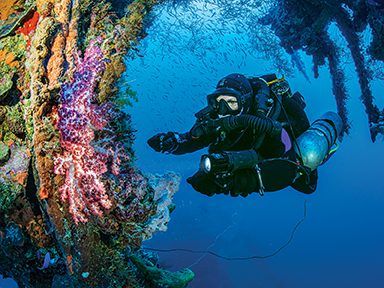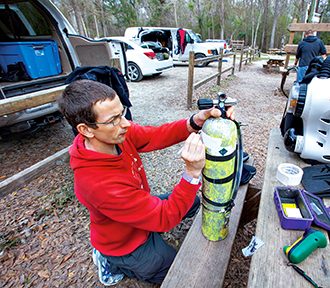DIFFERENT TERMS CAN SOMETIMES DESCRIBE the same piece of equipment in the dive industry. What some divers call a dive light, for example, others call a dive torch. They are physically identical, so the names are interchangeable without causing more than minor confusion at worst.
Divers may also casually or mistakenly exchange terminology for two pieces of equipment that are different, such as a spool and a reel. Reels contain spools, but spools are functionally different from reels, so the term you use is relevant to the device and its operation and application.
In some cases, a piece of equipment has multiple uses. Divers might describe the same object as a decompression cylinder, a stage cylinder, or a bailout cylinder. Although each cylinder could be physically identical, the uses and required training for each are vastly different. As such, divers should be mindful of choosing the correct identifier for each piece of equipment.
CYLINDER SIMILARITIES
Decompression cylinders, stage cylinders, and bailout cylinders are primarily used by technical divers during complex dives involving a variety of gas mixes and potentially several cylinders. Technical divers carry them in addition to the main equipment configuration — such as doubles, sidemount, or a rebreather — they plan to use during a dive. Special gas-planning techniques are necessary when diving with these cylinders to ensure that, even with a catastrophic failure, all divers can safely make it back to the surface.
All three cylinders may have identical sizes and corresponding rigging techniques in common. An 80-cubic-foot (11.1-liter) aluminum cylinder is the most common. Sometimes divers use 40-cubic-foot (5.7-liter) aluminum cylinders for both decompression and bailout and may occasionally use 72-cubic-foot (10-liter) aluminum cylinders as stages. Divers rarely use steel cylinders due to their negatively buoyant characteristics. Regardless of size, the rigging is typically similar, with slight variations from diver to diver to meet individual needs.

JILL HEINERTH
CYLINDER DIFFERENCES
Decompression cylinders: As the name suggests, decompression cylinders contain gas that divers use during staged decompression dives, which include stops at various depths for predetermined lengths of time before surfacing to allow for efficient offgassing. Decompression gas typically contains more than 40 percent oxygen, and a diver may carry more than one decompression mix on longer, deeper dives.
In nonoverhead environments, divers typically carry decompression cylinders throughout the dive and breathe from them after reaching a safe depth for the mix’s maximum operating depth (MOD). Divers try to avoid dropping these cylinders when diving in open water so they can ascend at any point during the dive if an emergency arises.
In overhead environments such as caves, most divers leave their decompression cylinders at the beginning of the dive for use when they reach the exit. This practice is acceptable because there is typically only one way in and out.
Stage cylinders: Stage cylinders allow divers to increase penetration distance in an overhead environment, such as a cave, wreck, or mine. Divers breathe from cylinders that they place at predetermined intervals along their path. Some divers drop these cylinders based on pressure, while others drop them based on time. While making their way out, divers pick up the cylinders and use them. Regardless of the divers’ gas management method, all team members must agree on a procedure before commencing the dive.
Note that environmental conditions may affect a chosen procedure, such as carrying a stage cylinder farther into high-flow cave systems so that gas is more readily available in case it is needed quickly.
Bailout cylinders: Rebreather divers use bailout cylinders in case a catastrophic loop failure requires a switch to open circuit. Divers must be mindful of the bailout cylinder gas’s MOD, because they must be able to breathe it at the dive’s maximum planned depth.

JILL HEINERTH
Unlike stage cylinders, divers carry bailout cylinders throughout the dive to immediately access breathing gas if a rebreather failure occurs. Some dive plans for overhead environments include placing additional bailout cylinders at predetermined distances. A diver must always have sufficient gas attached to them for the transport time needed to travel safely to their next previously dropped cylinder. Best practice is for each diver to carry enough bailout gas to perform a self-rescue and get back to the surface safely on their own.
Generally, divers should always abide by their training agency’s recommendations …
CLOSING THOUGHTS
Divers need extra training to carry additional breathing gas. Whether decompression, stage, or bailout cylinders, each requires additional training. Divers may take decompression procedures, wreck penetration, or cave diving courses to expand their skills and knowledge. Even though these cylinders may look the same in size and rigging, each has a unique function within a dive plan. It is important to note that divers may carry more than one type of cylinder on any given dive, such as carrying both stage and decompression cylinders on an open-circuit cave dive.
Generally, divers should always abide by their training agency’s recommendations and stay within the scope of their training to help ensure that every dive is as safe as possible. Divers should strive to understand the terminology and use it appropriately. Doing so helps decrease confusion, which ultimately increases a team’s safety.
Decompression cylinders, stage cylinders, and bailout cylinders are different pieces of equipment, and properly referring to each type will ensure everyone knows their intended use. AD
© Penyelam Siaga — Q4 2022